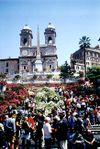Mantua
| Mantua | |||
|---|---|---|---|
| — Comune — | |||
| Comune di Mantova | |||
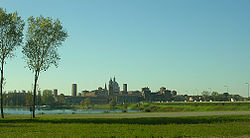 |
|||
|
|||
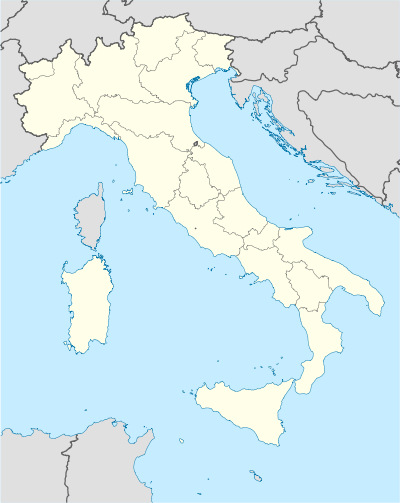 Mantua
|
|||
| Coordinates: | |||
| Country | Italy | ||
| Region | Lombardy | ||
| Province | Mantua (MN) | ||
| Frazioni | Castelletto Borgo, Cittadella, Formigosa, Frassino, Gambarara, Lunetta, Virgiliana | ||
| Government | |||
| - Mayor | Nicola Sodano (The People of Freedom) | ||
| Area | |||
| - Total | 63.97 km2 (24.7 sq mi) | ||
| Elevation | 19 m (62 ft) | ||
| Population (31 June 2009) | |||
| - Total | 48,353 | ||
| - Density | 755.9/km2 (1,957.7/sq mi) | ||
| Demonym | Mantovani | ||
| Time zone | CET (UTC+1) | ||
| - Summer (DST) | CEST (UTC+2) | ||
| Postal code | 46100 | ||
| Dialing code | 0376 | ||
| Patron saint | Anselm of Lucca, the Younger | ||
| Saint day | March 18 | ||
| Website | Official website | ||
Mantua (Italian: Màntova listen, in the local dialect of Emilian language Mantua) is a city and comune in Lombardy, Italy and capital of the province of the same name. Mantua's historic power and influence under the Gonzaga family, made it one of the main artistic,[1] cultural and notably musical hubs of Northern Italy and the whole country itself. Mantua is noted for its significant role in the history of opera,[2] and the city is known for its several architectural treasures and artifacts, elegant palaces or palazzi, and its medieval and Renaissance cityscape.
Mantua is surrounded on three sides by artificial lakes created during the 12th century.[3] These receive the waters from the Mincio, which descend from Lake Garda. The three lakes are called Lago Superiore, Lago di Mezzo, and Lago Inferiore ("Superior", "Middle", and "Inferior" Lakes).[4] A fourth lake, Lake Pajolo, which once completed a defensive water ring of the city, dried up at the end of the 18th century.
Contents |
History
The city was founded, probably around 2000 BC , on the banks of the Mincio, on a sort of island which provided natural protection. In the 6th century BC it was an Etruscan village which, in Etruscan tradition, was re-founded by Ocnus[5].
The name derives from the Etruscan god Mantus, of Hades. After being conquered by the Cenomani, a Gallic tribe, the city was conquered by the Romans between the first and second Punic wars, confusing its name with Manto, a daughter of Tyresia (Tiresias). The new territory was populated by veteran soldiers of Augustus. Mantua's most famous ancient citizen is the poet Publius Vergilius Maro, Virgil (Mantua me genuit), who was born near the city in 70 B.C.[6]
After the fall of the Roman Empire, Mantua was invaded in turn by Byzantines, Longobards and Franks. In the 11th century it became a possession of Boniface of Canossa, marquis of Toscana. The last ruler of the family was the countess Matilda of Canossa (d. 1115), who, according to legend, ordered the construction of the precious Rotonda di San Lorenzo (1082).
After the death of Matilde of Canossa, Mantua became a free commune, and strenuously defended itself from the Holy Roman Empire in the 12th and 13th centuries. In 1198 Alberto Pitentino optimised the course of the Mincio, creating what Mantuans call "the four lakes" to reinforce the city's natural protection. Between 1215 and 1216 the city was under the podesteria of the Guelph Rambertino Buvalelli.
During the struggle between the Guelphs and the Ghibellines, Pinamonte Bonacolsi took advantage of the chaotic situation to seize power in 1273. His family ruled Mantua for the next century, making it more prosperous and artistically beautiful. On August 16, 1328, the last Bonacolsi, Rinaldo, was overthrown in a revolt backed by the House of Gonzaga, a family of officials. Luigi Gonzaga, who had been podestà of the city in 1318, was elected "People's Captain". The Gonzaga built new walls with five gates and renovated the architecture of the city in the 14th century, but the political situation in the city did not settle until the third Gonzaga, Ludovico I Gonzaga, eliminated his relatives, seizing power for himself. During the Renaissance, the Gonzaga family softened their despotic rule of Mantua and raised the level of culture and refinement in Mantua.[7]
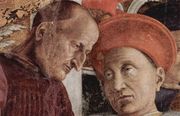
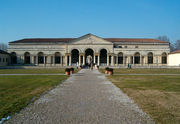
Through a payment of 120,000 golden florins in 1433, Gianfrancesco I was appointed marquis of Mantua by Emperor Sigismund, whose daughter Barbara of Brandenburg he married. In 1459 Pope Pius II held a diet in Mantua to proclaim a crusade against the Turks. Under Francesco II the famous Renaissance painter Andrea Mantegna worked in Mantua as court painter, producing some of his most outstanding works.
The first Duke of Mantua was Federico II Gonzaga, who acquired the title from Emperor Charles V in 1530. Federico commissioned Giulio Romano to build the famous Palazzo Te, on the periphery of the city, and profoundly improved the urbanistic asset of the city.
In 1627, the direct line of the Gonzaga family came to an end with the vicious and weak Vincenzo II, and the town slowly declined under the new rulers, the Gonzaga-Nevers, a cadet French branch of the family. The War of the Mantuan Succession broke out, and in 1630 an Imperial army of 36,000 Landsknecht mercenaries besieged Mantua, bringing the plague with them. Mantua never recovered from this disaster. Ferdinand Carlo IV, an inept ruler whose only aim was to hold parties and theatrical representations, allied with France in the Spanish Succession War. After the latter's defeat, he took refuge in Venice, carrying with him a thousand pictures. At his death, in 1708, he was declared deposed and his family lost Mantua forever in favour of the Habsburgs of Austria.
Under Austrian rule, Mantua enjoyed a revival, and during this period the Royal Academy of Sciences, Letters and Arts, the Scientific Theatre, and numerous Palaces were built.
On June 4, 1796, during the Napoleonic Wars, Mantua was besieged by Napoleon as a move against Austria, who joined the First Coalition. Austrian and Russian attempts to break the siege failed, but spread the French thin enough to abandon the siege on 31 July to fight other battles. The siege resumed on August 24. In early February the city surrendered and the region came under French administration. Two years later, in 1799, the city was retaken by the Austrians.
Later, the city was again passed to Napoleon's control. In the year 1810 by Porta Giulia, a gate of the town at Borgo di Porto (Cittadella), Andreas Hofer was shot; he had led the insurrection of the Tyrol against Napoleon.
After the brief French rule, Mantua returned to Austria in 1814, becoming one of the Quadrilatero fortress cities in northern Italy. Agitation against Austria culminated in a revolt which lasted from 1851 to 1855, and was finally suppressed by the Austrian army. One of the most famous episodes of Italian Risorgimento took place in the valley of Belfiore, when a group of rebels was hanged by the Austrians.
In 1866, Mantua was incorporated in united Italy by the king of Sardinia.
Main sights

| Mantua and Sabbioneta* | |
|---|---|
| UNESCO World Heritage Site | |
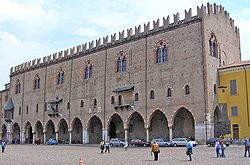
Palazzo Ducale
|
|
| State Party | |
| Type | Cultural |
| Criteria | ii, iii |
| Reference | 1287 |
| Region** | Europe and North America |
| Inscription history | |
| Inscription | 2008 (32nd Session) |
| * Name as inscribed on World Heritage List. ** Region as classified by UNESCO. |
|
The Gonzaga protected art and culture, and hosted several important artists like Leone Battista Alberti, Andrea Mantegna, Giulio Romano, Donatello, Peter Paul Rubens, Pisanello, Domenico Fetti, Luca Fancelli and Nicolò Sebregondi. Though many of the masterworks have been dispersed, the cultural value of Mantua is nonetheless outstanding. Many monuments furnish examples of unique patrimony in patrician buildings and Italian architecture.
Main landmarks include:
- The Palazzo Te (1525–1535), a creation of Giulio Romano (who lived in Mantua in his final years) in the style of mature Renaissance and with some hints of a certain post-Raphaelian mannerism. It was the summer residential villa of Frederick II of Gonzaga. It hosts the Museo Civico (with the donations of Arnoldo Mondadori, one of the most important Italian publishers, and Ugo Sissa, a Mantuan architect who worked in Iraq from where he brought back important Mesopotamian artworks)
- The Palazzo Ducale, famous residence of the Gonzaga family, made up by a number of buildings, courtyards and gardens gathered around the Palazzo del Capitano, the Magna Domus, and the Castle of St. George.
- The Basilica of Sant'Andrea
- The Duomo
- The Rotonda di San Lorenzo
- The Bibiena Theater
- The church of San Sebastiano
- The Palazzo Vescovile ("Bishops Palace")
- The Palazzo degli Uberti
- The Torre della Gabbia ("Cage Tower")
- The Palazzo del Podestà that hosts the museum of Tazio Nuvolari
- The Palazzo della Ragione with the Torre dell'Orologio ("Clock Tower")
- The Palazzo Castiglioni Bonacolsi
- The Palazzo Valenti Gonzaga, an example of architecture and decorations of Baroque period, decorated with frescoes attributed to Flemish painter Frans Geffels. The facade of the palace was designed by Nicolò Sebregondi.
Transportation
Mantua lies across the Milan-Codogno-Cremona-Mantova. By car, it can be reached through the A4 (Milan-Venice) Highway to Verona, and from there Highway A22 (Brennero-Modena). Otherwise, through the State road 415 (Milan-Cremona) to Cremona, and from there State road 10 (Cremona-Mantova).
The closest airport is Verona-Villafranca.
Miscellany
- An annual survey of Legambiente (an ecologist movement of Italy) in 2005 declared Mantua the most liveable city of the country. The study was based on levels of pollution, quality of life, traffic of cars, and public transportation, among other criteria. [1]
- The body of Saint Longinus, twice recovered and lost, was asserted to have been found once more at Mantua in 1304, together with the Holy Sponge stained with Christ's blood.
- In William Shakespeare's play Romeo and Juliet, Romeo spends his period of exile—his punishment for killing Tybalt—in Mantua. Also, in Shakespeare's play Taming of the Shrew, the schoolmaster who pretends to be Lucentio's father, Vincentio, is from this city.
- Giuseppe Verdi's opera Rigoletto (based on Victor Hugo's play Le roi s'amuse) is set in Mantua. Austro-Hungarian authorities in Venice forced him to move the action from France to Mantua.
- Since 1997 Mantua has hosted the Festivaletteratura, one of the most renowned literary events in Europe.
- In 2007 the remains of two people were discovered during the construction of a factory. The remains are thought to be between 5,000 and 6,000 years old. It is speculated that the remains are of two young lovers because the two skeletons appear to be embracing. [2]
Namesakes
As with many European cities, Mantua has been the inspiration for the names of many other settlements, including:
- Canada
Mantua, a village in West Hants, Nova Scotia
- U.S.A.
Mantua, Ohio, Mantua, Utah, Mantua, New Jersey, Mantua, Virginia, the Mantua district of Philadelphia, Pennsylvania, the village of Mantua in Baltimore County, Maryland, the hamlet of Mantua (sometimed spelled Manatua) in Greene County, Alabama, and a location in Monroe County, Iowa.
Twin cities
|
Famous citizens
- Virgil (70 BCE–19 BCE), a classical Roman poet.
- Sordello or Sordel, a 13th-century Lombard troubadour, born in the municipality of Goito in the province of Mantua.
- Pietro Pomponazzi (1462–1525), an Italian philosopher. He is sometimes known by his Latin name, Petrus Pomponatius.
- Giovanni Battista Bertani (1516–1576), architect.
- Leone de' Sommi (c. 1525–c. 1590), theater director and writer.
- Claudio Monteverdi (c. 1567-1643), composer.
- Giuseppe Sarto (1835–1914), appointed Bishop in 1884 before he became Pope Pius X in 1903.
- Alberto Jori, neo-aristotelian philosopher.
See also
- Roman Catholic Diocese of Mantova
Tazio Nuvolari "The flying Mantuan" World famous racing Driver. Born in Mantova.There is a museum dedicated to his exploits.
Notes
- ↑ http://www.getty.edu/bookstore/titles/mantua.html
- ↑ http://www.britannica.com/EBchecked/topic/238579/Giovan-Francesco-II-Gonzaga
- ↑ "Mantua and the Gonzaga domains". UNESCO World Heritage Centre. 2006-06-01. http://whc.unesco.org/en/tentativelists/328/. Retrieved 2006-09-18.
- ↑ "Parco del Mincio". Comune di Mantova. http://www.comune.mantova.it/Culture_tourism/tourist_itinerary/mantua_nature/parco_mincio. Retrieved 2006-09-18.
- ↑ Fagles, Robert: The Aeneid (2006), 10.242, Penguin Group, ISBN 0-670-03803-2
- ↑ Conte, Gian Biagio. Trans. Joseph B. Solodow Latin Literature: A History. Johns Hopkins University Press, 1994.
- ↑ Henry S. Lucas, The Renaissance and the Reformation (Harper & Bros. Publishers: New York, 1960) pp. 42-43.
External links
- Official website
- Palazzo Te (in Italian)
- Palazzo Ducale (in Italian)
- A Mantova To know and to see Mantua
|
|||||||
|
|||||||||||||||||||||||||||||||
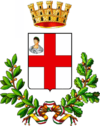

_-_The_Last_Supper_(1495-1498).jpg)


